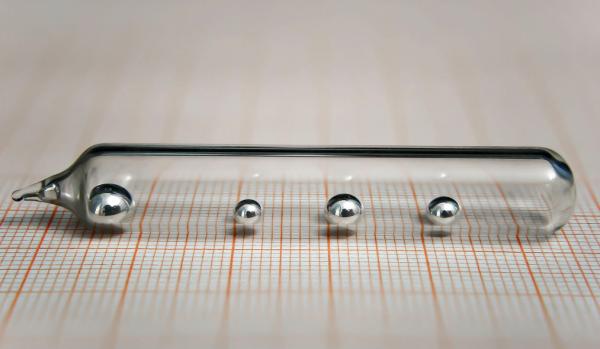
Every once in a while, I like to write about unusual elements. While you don't run into them all that often, some of those bad boys are pretty strange. Here are a couple that I've written about in the past:
Fluorine: The Element From Hell (contains a video of some lunatics burning up a raw chicken with fluorine gas)
Beryllium- A Rather Strange Element
Here's another - gallium. You may not have even heard of it. The metal does not exist in elemental form anywhere on earth. Rather, it is found in combination with other elements in minerals, most commonly gallite, which has the odd formula CuGaS2.

Gallite Photo: Minerman.com Specimens like this can be extremely valuable.
What makes gallium unique is that is the only element with such a melting point that is so low (85º F) that, unlike M&Ms, it will melt in your hand.
Quiz: There are only two elements that exist as liquids at room temperature. Can you name them? (1)

Free Image: Tor Paulin, Flickr
Another form of gallium is a mineral called galloplumbogummite - a name that only a mother could love. And the formula is enough to induce a seizure: Pb(Ga,Al)3-xGexH1-x(PO4)2(OH)6

Galloplumbogummite from the Tsumeb Mine, Otavi Highlands, Namibia. Wheel of Fortune, anyone?
Chemistry: Gallium is rarely used in chemistry. In my 35 years on the bench, I never used it or knew of anyone else who did. There is one reaction of gallium that I did find. But, you would have to be out of your mind to run it:
2Ga + 3Me2Hg → 2Me3Ga + 3 Hg
I don't know why someone would want trimethylgallium, but they had better want it REALLY badly. This is because the chemical that it is made from— dimethylmercury (bold)—might be the scariest stuff on earth to work with. It is so toxic that a chemistry professor at Dartmouth spilled a drop or two on the back of one of her latex gloves, and died from mercury poisoning less than a year later. There was nothing anyone could do to save her.
(See: Two Drops Of Death: Dimethylmercury)
So, what is gallium used for? Some of the answers may surprise you.
- Since mercury is no longer used in thermometers, gallium is the perfect alternative because of its low melting point. But 85º F is still to high for a thermometer. It wouldn't become liquid until you put it into your mouth. But an alloy of gallium called galinstan, which contains indium (another obscure element) and tin, Doesn't solidify until you get to below zero Fahrenheit. Galinstan, unlike mercury, is non-toxic.
-
There is actually an FDA approved drug containing gallium (2) called Ganite (gallium nitrate), which is approved to excess calcium in the blood, which can result from certain cancers. Hypercalcemia (excess calcium) can be dangerous when calcium levels get too high. Hydration with saline is the first treatment, but if this fails, Ganite can be used to remove the excess calcium in the blood.
-
A radioactive isotope 67Ga(III) citrate (aka Neoscan) was used for detection of lymphomas, since it accumulates in lymph nodes (3), but has been replaced by 18F-FDG PET/CT, which uses radioactive fluorodeoxyglucose (18F) in conjunction with positron emission and CT scans.
About 80 years ago is was found that gallium (III) tartrate might be useful for treatment of syphilis. It worked in rabbits, but not so well in people. And a radioactive isotope 62Ga was tested an anticancer agent, under the premise that it would accumulate in cancer cells and kill them with radioactivity. Didn't work.
Perhaps the most useful forms of the metal are gallium arsenide and gallium nitride. Both are semiconductors, but the latter is what makes Blu-ray work.

Gallium semiconductors (and cool looking crystals). Photo: Wikipedia
You may or may not find this stuff earth-shattering, but the same cannot be said for M&Ms. They are not pleased.

Note:
(1) This is a trick question. Bromine and mercury are the only liquid elements at room temperature. Both cesium and francium will melt in your hand, but they are so chemically reactive that in the presence of water, oxygen or carbon dioxide they react immediately. So this would need to be done in a completely inert atmosphere. And it's still a pretty bad idea. Although under these conditions, they will not only melt in your hand, but they will also melt your hand.
(2) I had no idea. Thanks to my former colleague Steve Schow for this bit of obscure information.
(3) There are two stable isotopes of gallium, gallium-69 and gallium-71. And two unstable isotopes, gallium-67 and gallium-68. Gallium-67 decays, emitting gamma-rays, which can be captured by a detector.



